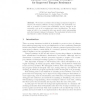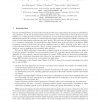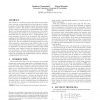CCS
2001
ACM
14 years 4 months ago
2001
ACM
Most people consider frequent software updates a nuisance. However, we show how this common phenomenon can be turned into a feature that protects against software piracy. We defin...
CCS
2001
ACM
14 years 4 months ago
2001
ACM
We describe a software self-checking mechanism designed to improve the tamper resistance of large programs. The mechanism consists of a number of testers that redundantly test for ...
CCS
2001
ACM
14 years 4 months ago
2001
ACM
Authenticating mobile computing users can require a significant amount of processing and communications resources— particularly when protocols based on public key encryption are...
CCS
2001
ACM
14 years 4 months ago
2001
ACM
hfulness of Abstract Protocol Analysis: Message Authentication∗ Joshua D. Guttman F. Javier Thayer Lenore D. Zuck December 18, 2002 Dolev and Yao initiated an approach to studyi...
CCS
2001
ACM
14 years 4 months ago
2001
ACM
Many encryption systems require the user to memorize high entropy passwords or passphrases and reproduce them exactly. This is often a difficult task. We propose a more fault-tole...
CCS
2001
ACM
14 years 4 months ago
2001
ACM
CCS
2001
ACM
14 years 4 months ago
2001
ACM
XML is increasingly becoming the format of choice for information exchange on the Internet. As this trend grows, one can expect that documents (or collections thereof) may get qui...
CCS
2001
ACM
14 years 4 months ago
2001
ACM
Abstract. We describe a weakness in the High Bandwidth Digital Content Protection (HDCP) scheme which may lead to practical attacks. HDCP is a proposed identity-based cryptosystem ...
CCS
2001
ACM
14 years 4 months ago
2001
ACM
The events of a security protocol and their causal dependency can play an important role in the analysis of security properties. This insight underlies both strand spaces and the ...
CCS
2001
ACM
14 years 4 months ago
2001
ACM
Abstract. Protection of software code against illegitimate modifications by its users is a pressing issue to many software developers. Many software-based mechanisms for protectin...



